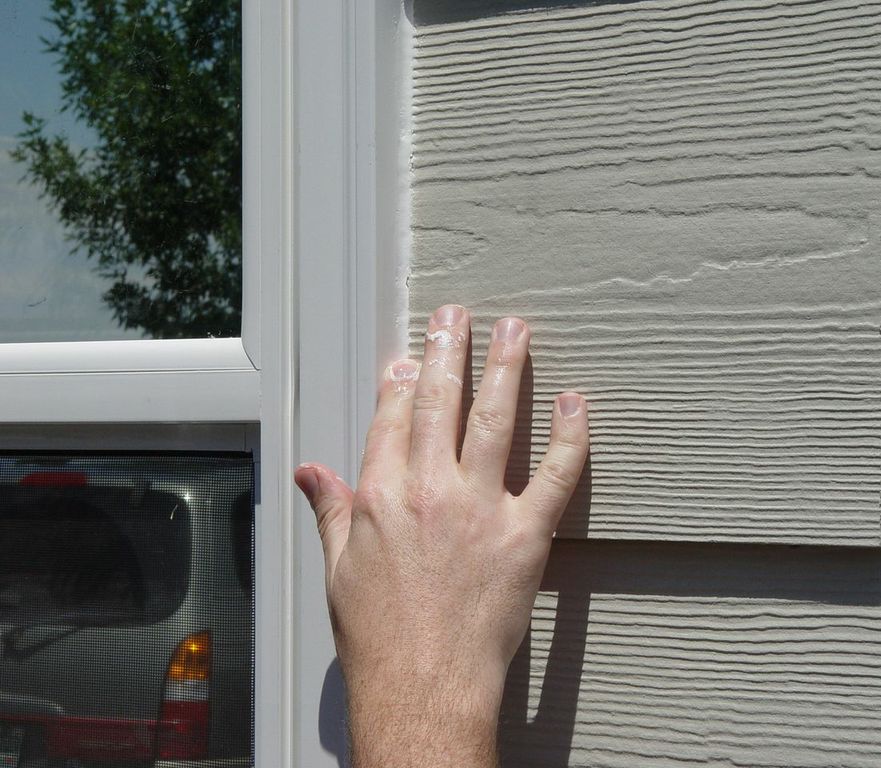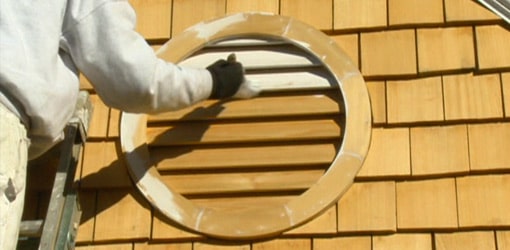The places on the exterior of the house that need careful caulking before painting would be the fascia board joints of the overhang. Particularly at the corners where they are mitered together. Also any butt joints and joints at the peak of diagonal fascia boards. The next place would be the soffits or the plywood underneath the overhang at the joints where they meet the fascia and the siding. The caulk around all windows and doors on all sides should be checked for cracks and missing caulk. The bases of columns, the top of shutters, joints of the rail systems, and the panels of bay windows.
It’s important to caulk the door sill and around the frame of the door at the sill to prevent water intrusion.
Above windows that are set into a brick wall there is a lintel or a metal beam above the window to hold up the brick. These should be caulked where the lintel meets the wood casement or frame of the window. Do not caulk the front edge of the lintel at the brick as this must be allowed to weep any moisture from the brick. Also, where the siding meets corner boards and corner board joints. Another critical place is where the siding butts together in the middle of the wall. These siding joints can be caulked successfully if the gap is wide enough for the caulk to get into the crack. If the siding joint is so tight that the caulk only bridges the gap it may split again. Sometimes the old caulk in the siding joint is cracked and you need to cut the old caulk out with a razor knife. This allows for the caulk to get in and fill the gap correctly.
Basically any crack on the exterior of the house should be filled. Exceptions to this would be underneath the bottom edge of siding and the front edge of the lintels as discussed above.
How do I cut a caulk tube?
You want to cut the tube tip at approximately a 45° angle. Then take a long nail and insert it through the tip of the tube to break the seal. The hole should be about 3/16 of an inch for most caulking joints.
Caulking on the exterior siding joints at the corner board if done carefully, does not need to be smoothed with a finger. Most other areas were caulk is necessary should be lightly smoothed with your finger. If the hole in the tube is too large you will find yourself removing an excessive amount of caulk. Cut the next tube smaller and you will have less removal of excess caulk.
Do I have to remove all the old caulk on the exterior of my house before I apply new caulk?
The basic guideline is if the caulk is just split and is still functional and is difficult to remove do not remove the old caulk .Simply caulk the split that has occurred. The goal is to keep water out of the joint. If the caulk can be removed easily and will strip out by just pulling it then remove that section of caulk.
What’s the best caulk to use on the exterior of my house?
Use a high-quality acrylic caulk for most applications. Sherwin-Williams have two products we consider to be excellent. Storm Blaster and Proflex caulk are among the longest lasting. You can get Proflex in either white or clear. The clear caulk is great around brick and stone. These caulks have great longevity and remain flexible throughout their lifetime.
How do I caulk trim inside my house?
Use a caulk tube tip that has been cut at a 45° angle with a small hole about the size of a BB. After applying 3 to 5 feet use a wet rag to wipe off all the excess leaving the crack filled and no excess caulk showing.
How do I seal the inside of my leaking gutters?
You can use Proflex caulk inside your gutters to seal the end caps and the miter joints.







